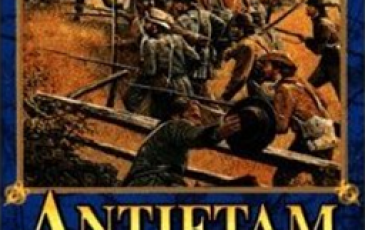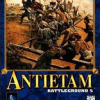24 Sep 61, Hanging Rock, WV - Battleground 5: Antietam

| Rating: | 0 (0) |
| Games Played: | 0 |
| SM: | 3 |
| Turns: | 17 |
| Type: | Custom |
| First Side: | Union |
| Second Side: | CSA |
| Downloads: | 27 |
24 September, Hanging Rock, WV [Curt Cabbage]
A major skirmish, known as the Battle of Hanging Rocks Pass, took place at Hanging Rocks on Tuesday morning 24 September 1861.[1][2][3][5][19][20] The skirmish took place between the Confederate Hampshire Militia led by Colonel Angus William McDonald and several companies of Union troops under the command of Colonel Cantwell of the 82nd Ohio Infantry.[2][20]
On the evening of 23 September 1861, Colonel McDonald received information that Union forces planned an attempt to pass through the gap at Hanging Rocks early the next morning.[2][20] Upon learning of this, McDonald and his 26 other men of the Hampshire Militia climbed to the top of Hanging Rocks in the early morning of 24 September in preparation for the arrival of Union troops.[2] McDonald also sent a scouting party down the South Branch on the night of 23 September.[2]
Hanging Rocks was a strategic location during the American Civil War.[20] Troops traveling between Romney and points north, including Cumberland and Green Spring, naturally utilized the Romney and Cumberland Pike at the base of Hanging Rocks.[2] In addition, the shallow nature of the South Branch at Hanging Rocks created a crossing which allowed for a secondary connection of the Romney and Cumberland Pike to the Northwestern Turnpike at Mechanicsburg via Fox Hollow.[2]
Upon taking to the summit, McDonald and his men piled boulders at the precipice of Hanging Rocks' cliffs to hurl at Union troops marching on the pike below.[2][20] The Confederates completed their preparations by daybreak.[2] McDonald instructed his men to be careful not to mistake their returning scouting party for the advancing Union troops.[2]
Shortly after daybreak, Union cavalry (a company of Ringgold Cavalry) crossed the ford on the South Branch at the north end of Hanging Rocks pass and its columns marched onto the pike below the awaiting Confederate militamen.[2][20] Initially, the Confederates atop the rocks lied flat trying to ascertain through the fog whether the approaching cavalry were their returning scouting party.[2] The Union troops at the base of Hanging Rocks were naturally suspicious of the strategic location and were on high alert as they crossed the ford and made their way onto the pike.[2] The Union troops noticed heads of the Confederate militamen peering over the cliffs and fired upon them.[2] The Confederates responded to the firing by hurling the boulders onto the road below causing the Union cavalry to hastily retreat down the pike and across the ford.[2][20] In their hasty retreat, several of the Union cavalry ran over their infantrymen forcing them into the river, where at least five drowned.[2][20]
Sergeant H. B. Hedge of the Ringgold Cavalry Company made the following record in his journal about the incident:[21]
On the morning of the 24th, we had our first fight of any real importance, at what is called the Hanging Rocks, eight miles from Romney. Just about daylight we crossed the river, encountered their pickets and drove them back; but to our surprise, their forces were on the rocks overhanging the road, and they opened a heavy fire on us. The Lieutenant Colonel in command of the column gave no orders whatever; all was confusion; we were afraid to go forward, and could not get back, as our teams had come across the river and blocked the narrow passage between the rocks and the stream.
Fortunately for us, the enemy did not know we were so demoralized, and after a few volleys, retreated. Captain Keys kept cool, rallied his men, and after the enemy ceased firing, marched back over the river. Our loss was very slight, as the enemy fired over our heads. Our casualties were mostly in the river among some of the infantrymen, who in attempting to swim to the other shore, came into range of the enemy's fire.[21]
The bodies of approximately a dozen Union soldiers were interred in the sand of the South Branch's western bank following the skirmish.[2] High water the following Saturday 28 September washed additional bodies down the river which were also retrieved from the South Branch and buried.[2]
The Confederates were unaware, because of the earlier fog and the false report of a Union advance, that the Union troops were actually in retreat upon their arrival at Hanging Rocks.[20] The Confederates left Hanging Rocks gap and pulled back to Romney
A major skirmish, known as the Battle of Hanging Rocks Pass, took place at Hanging Rocks on Tuesday morning 24 September 1861.[1][2][3][5][19][20] The skirmish took place between the Confederate Hampshire Militia led by Colonel Angus William McDonald and several companies of Union troops under the command of Colonel Cantwell of the 82nd Ohio Infantry.[2][20]
On the evening of 23 September 1861, Colonel McDonald received information that Union forces planned an attempt to pass through the gap at Hanging Rocks early the next morning.[2][20] Upon learning of this, McDonald and his 26 other men of the Hampshire Militia climbed to the top of Hanging Rocks in the early morning of 24 September in preparation for the arrival of Union troops.[2] McDonald also sent a scouting party down the South Branch on the night of 23 September.[2]
Hanging Rocks was a strategic location during the American Civil War.[20] Troops traveling between Romney and points north, including Cumberland and Green Spring, naturally utilized the Romney and Cumberland Pike at the base of Hanging Rocks.[2] In addition, the shallow nature of the South Branch at Hanging Rocks created a crossing which allowed for a secondary connection of the Romney and Cumberland Pike to the Northwestern Turnpike at Mechanicsburg via Fox Hollow.[2]
Upon taking to the summit, McDonald and his men piled boulders at the precipice of Hanging Rocks' cliffs to hurl at Union troops marching on the pike below.[2][20] The Confederates completed their preparations by daybreak.[2] McDonald instructed his men to be careful not to mistake their returning scouting party for the advancing Union troops.[2]
Shortly after daybreak, Union cavalry (a company of Ringgold Cavalry) crossed the ford on the South Branch at the north end of Hanging Rocks pass and its columns marched onto the pike below the awaiting Confederate militamen.[2][20] Initially, the Confederates atop the rocks lied flat trying to ascertain through the fog whether the approaching cavalry were their returning scouting party.[2] The Union troops at the base of Hanging Rocks were naturally suspicious of the strategic location and were on high alert as they crossed the ford and made their way onto the pike.[2] The Union troops noticed heads of the Confederate militamen peering over the cliffs and fired upon them.[2] The Confederates responded to the firing by hurling the boulders onto the road below causing the Union cavalry to hastily retreat down the pike and across the ford.[2][20] In their hasty retreat, several of the Union cavalry ran over their infantrymen forcing them into the river, where at least five drowned.[2][20]
Sergeant H. B. Hedge of the Ringgold Cavalry Company made the following record in his journal about the incident:[21]
On the morning of the 24th, we had our first fight of any real importance, at what is called the Hanging Rocks, eight miles from Romney. Just about daylight we crossed the river, encountered their pickets and drove them back; but to our surprise, their forces were on the rocks overhanging the road, and they opened a heavy fire on us. The Lieutenant Colonel in command of the column gave no orders whatever; all was confusion; we were afraid to go forward, and could not get back, as our teams had come across the river and blocked the narrow passage between the rocks and the stream.
Fortunately for us, the enemy did not know we were so demoralized, and after a few volleys, retreated. Captain Keys kept cool, rallied his men, and after the enemy ceased firing, marched back over the river. Our loss was very slight, as the enemy fired over our heads. Our casualties were mostly in the river among some of the infantrymen, who in attempting to swim to the other shore, came into range of the enemy's fire.[21]
The bodies of approximately a dozen Union soldiers were interred in the sand of the South Branch's western bank following the skirmish.[2] High water the following Saturday 28 September washed additional bodies down the river which were also retrieved from the South Branch and buried.[2]
The Confederates were unaware, because of the earlier fog and the false report of a Union advance, that the Union troops were actually in retreat upon their arrival at Hanging Rocks.[20] The Confederates left Hanging Rocks gap and pulled back to Romney























